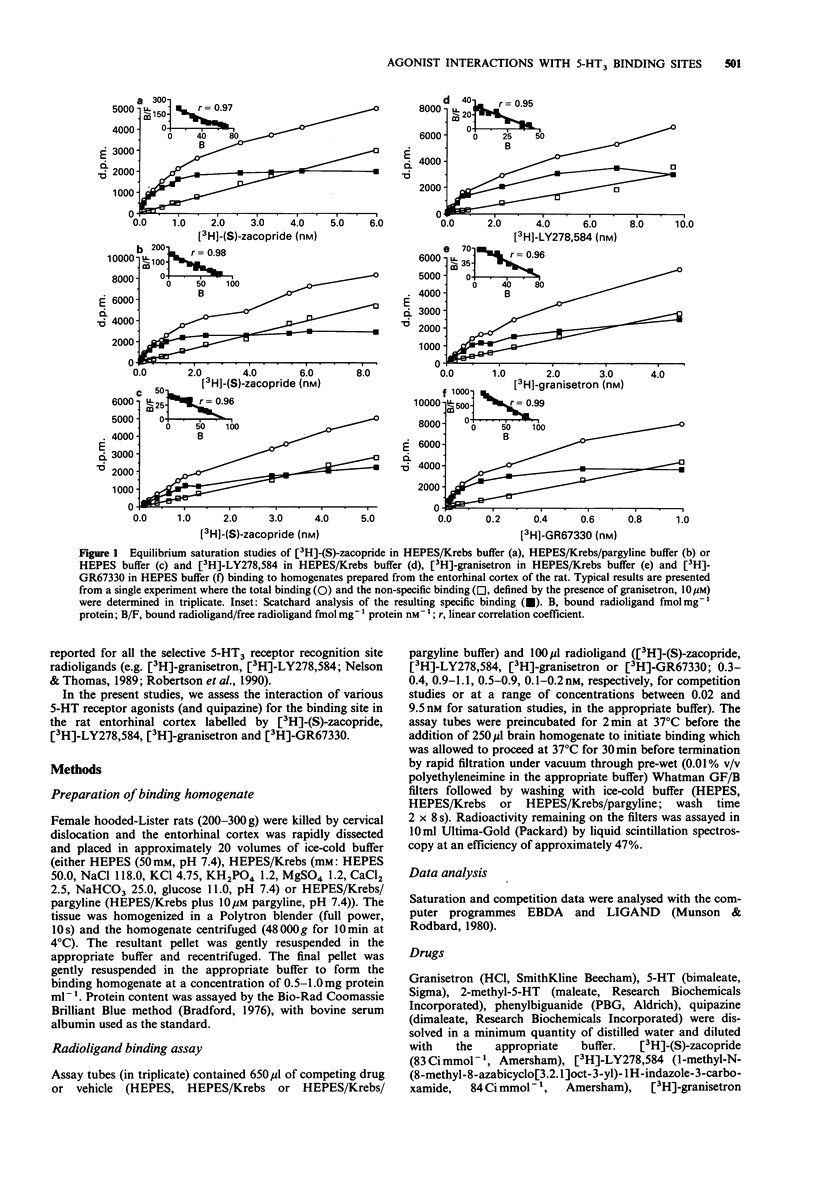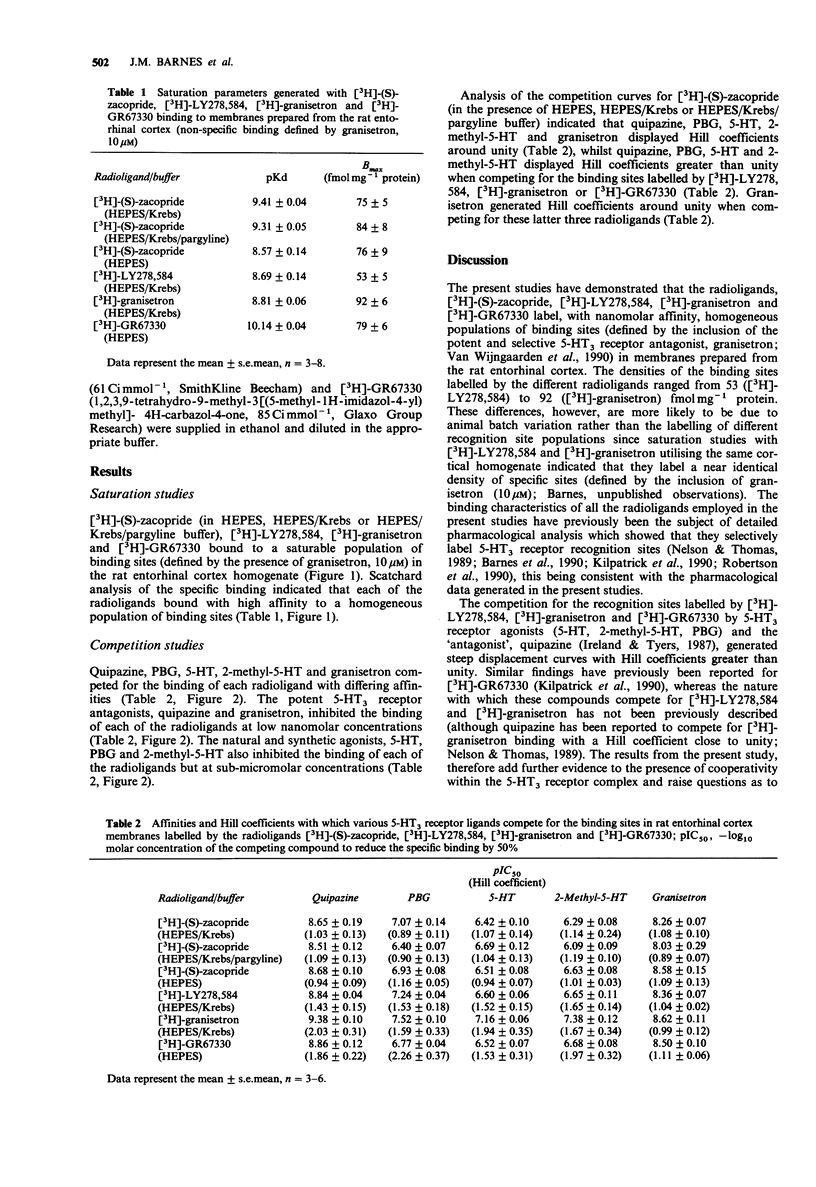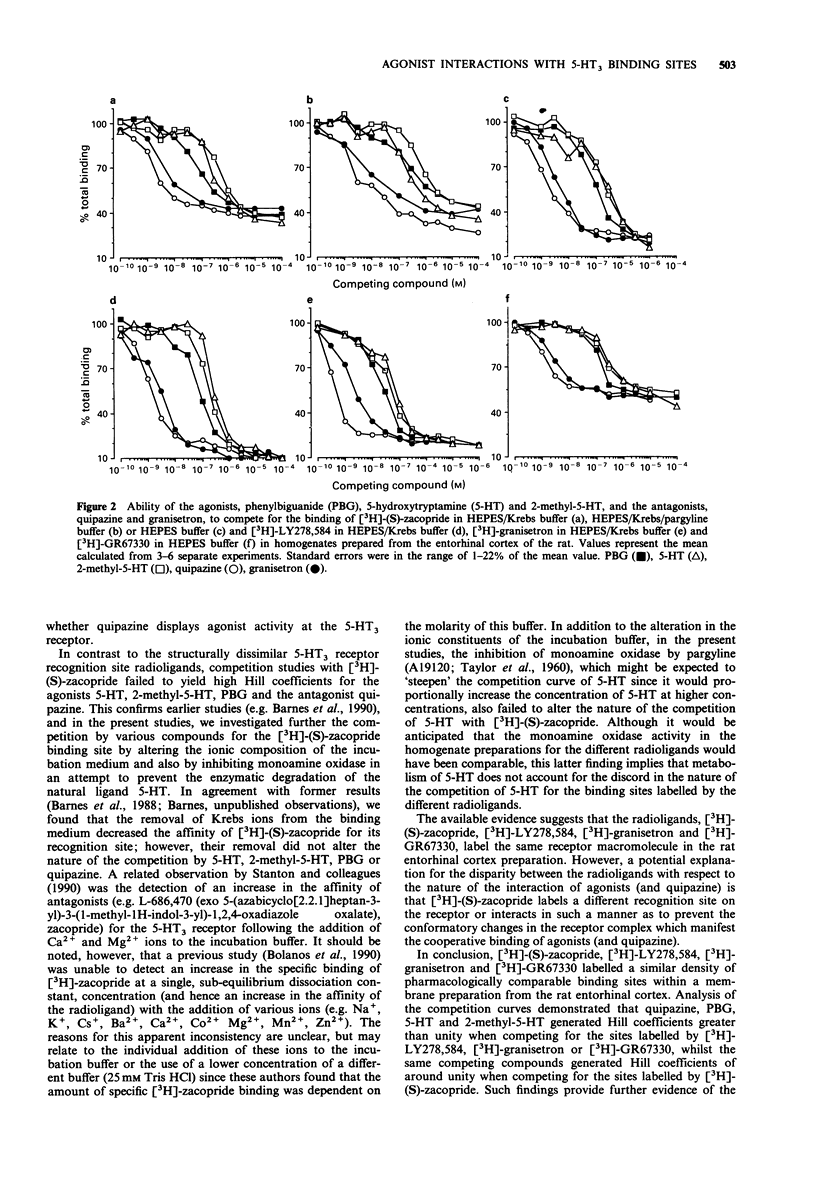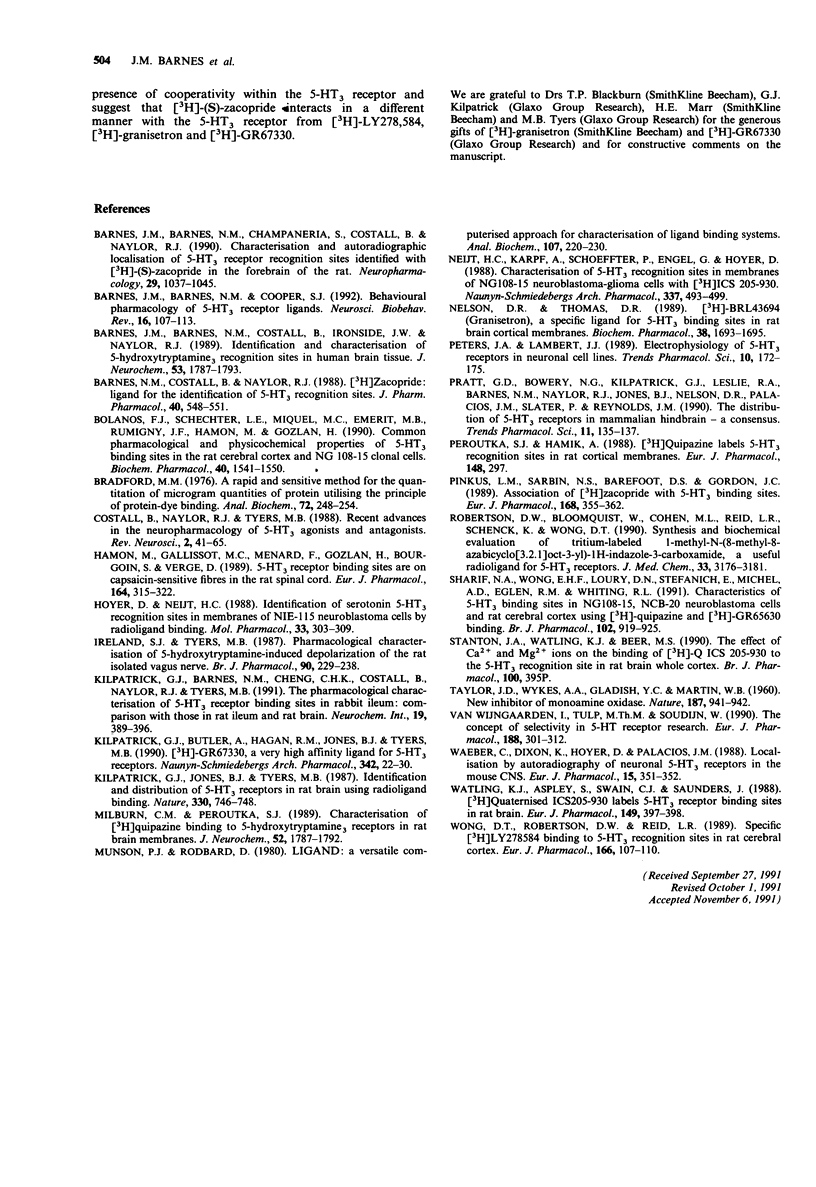Abstract
1. The pharmacological properties of 5-HT3 receptor recognition sites labelled with [3H]-(S)-zacopride, [3H]-LY278,584, [3H]-granisetron and [3H]-GR67330 in membranes prepared from the rat entorhinal cortex were investigated to assess the presence of cooperativity within the 5-HT3 receptor complex. 2. In rat entorhinal cortex homogenates, [3H]-(S)-zacopride, [3H]-LY278,584, [3H]-granisetron and [3H]-GR67330 labelled homogeneous densities of recognition sites (defined by granisetron, 10 microM) with high affinity (Bmax = 75 +/- 5, 53 +/- 5, 92 +/- 6 and 79 +/- 6 fmol mg-1 protein, respectively; pKd = 9.41 +/- 0.04, 8.69 +/- 0.14, 8.81 +/- 0.06 and 10.14 +/- 0.04 for [3H]-(S)-zacopride, [3H]-LY278,584, [3H]-granisetron and [3H]-GR67330, respectively, n = 3-8). 3. Quipazine and granisetron competed for the binding of each of the radioligands in the rat entorhinal cortex preparation at low nanomolar concentrations (pIC50; quipazine 9.38-8.51, granisetron 8.62-8.03), whilst the agonists, 5-hydroxytryptamine (5-HT), phenylbiguanide (PBG) and 2-methyl-5-HT competed at sub-micromolar concentrations (pIC50; 5-HT 7.16-6.42, PBG 7.52-6.40, 2-methyl-5-HT 7.38-6.09). 4. Competition curves generated with increasing concentrations of quipazine, PBG, 5-HT and 2-methyl-5-HT displayed Hill coefficients greater than unity when the 5-HT3 receptor recognition sites in the entorhinal cortex preparation were labelled with [3H]-LY278,584, [3H]-granisetron and [3H]-GR67330. These competing compounds displayed Hill coefficients of around unity when the sites were labelled with [3H]-(S)-zacopride. Competition for the binding of [3H]-(S)-zacopride, [3H]-LY278,584, [3H]-granisetron and [3H]-GR67330 by granisetron generated Hill coefficients around unity.(ABSTRACT TRUNCATED AT 250 WORDS)
Full text
PDF




Selected References
These references are in PubMed. This may not be the complete list of references from this article.
- Barnes J. M., Barnes N. M., Champaneria S., Costall B., Naylor R. J. Characterisation and autoradiographic localisation of 5-HT3 receptor recognition sites identified with [3H]-(S)-zacopride in the forebrain of the rat. Neuropharmacology. 1990 Nov;29(11):1037–1045. doi: 10.1016/0028-3908(90)90110-d. [DOI] [PubMed] [Google Scholar]
- Barnes J. M., Barnes N. M., Cooper S. J. Behavioural pharmacology of 5-HT3 receptor ligands. Neurosci Biobehav Rev. 1992 Spring;16(1):107–113. doi: 10.1016/s0149-7634(05)80057-0. [DOI] [PubMed] [Google Scholar]
- Barnes J. M., Barnes N. M., Costall B., Ironside J. W., Naylor R. J. Identification and characterisation of 5-hydroxytryptamine 3 recognition sites in human brain tissue. J Neurochem. 1989 Dec;53(6):1787–1793. doi: 10.1111/j.1471-4159.1989.tb09244.x. [DOI] [PubMed] [Google Scholar]
- Barnes N. M., Costall B., Naylor R. J. [3H]zacopride: ligand for the identification of 5-HT3 recognition sites. J Pharm Pharmacol. 1988 Aug;40(8):548–551. doi: 10.1111/j.2042-7158.1988.tb05300.x. [DOI] [PubMed] [Google Scholar]
- Bolaños F. J., Schechter L. E., Miquel M. C., Emerit M. B., Rumigny J. F., Hamon M., Gozlan H. Common pharmacological and physico-chemical properties of 5-HT3 binding sites in the rat cerebral cortex and NG 108-15 clonal cells. Biochem Pharmacol. 1990 Oct 1;40(7):1541–1550. doi: 10.1016/0006-2952(90)90452-q. [DOI] [PubMed] [Google Scholar]
- Bradford M. M. A rapid and sensitive method for the quantitation of microgram quantities of protein utilizing the principle of protein-dye binding. Anal Biochem. 1976 May 7;72:248–254. doi: 10.1016/0003-2697(76)90527-3. [DOI] [PubMed] [Google Scholar]
- Hamon M., Gallissot M. C., Menard F., Gozlan H., Bourgoin S., Vergé D. 5-HT3 receptor binding sites are on capsaicin-sensitive fibres in the rat spinal cord. Eur J Pharmacol. 1989 May 19;164(2):315–322. doi: 10.1016/0014-2999(89)90472-x. [DOI] [PubMed] [Google Scholar]
- Hoyer D., Neijt H. C. Identification of serotonin 5-HT3 recognition sites in membranes of N1E-115 neuroblastoma cells by radioligand binding. Mol Pharmacol. 1988 Mar;33(3):303–309. [PubMed] [Google Scholar]
- Ireland S. J., Tyers M. B. Pharmacological characterization of 5-hydroxytryptamine-induced depolarization of the rat isolated vagus nerve. Br J Pharmacol. 1987 Jan;90(1):229–238. doi: 10.1111/j.1476-5381.1987.tb16844.x. [DOI] [PMC free article] [PubMed] [Google Scholar]
- Kilpatrick G. J., Butler A., Hagan R. M., Jones B. J., Tyers M. B. [3H] GR67330, a very high affinity ligand for 5-HT3 receptors. Naunyn Schmiedebergs Arch Pharmacol. 1990 Jul;342(1):22–30. doi: 10.1007/BF00178967. [DOI] [PubMed] [Google Scholar]
- Kilpatrick G. J., Jones B. J., Tyers M. B. Identification and distribution of 5-HT3 receptors in rat brain using radioligand binding. Nature. 1987 Dec 24;330(6150):746–748. doi: 10.1038/330746a0. [DOI] [PubMed] [Google Scholar]
- Micheletti R., Giudici L., Turconi M., Donetti A. 4-DAMP analogues reveal heterogeneity of M1 muscarinic receptors. Br J Pharmacol. 1990 Jul;100(3):395–397. doi: 10.1111/j.1476-5381.1990.tb15816.x. [DOI] [PMC free article] [PubMed] [Google Scholar]
- Milburn C. M., Peroutka S. J. Characterization of [3H]quipazine binding to 5-hydroxytryptamine3 receptors in rat brain membranes. J Neurochem. 1989 Jun;52(6):1787–1792. doi: 10.1111/j.1471-4159.1989.tb07258.x. [DOI] [PubMed] [Google Scholar]
- Munson P. J., Rodbard D. Ligand: a versatile computerized approach for characterization of ligand-binding systems. Anal Biochem. 1980 Sep 1;107(1):220–239. doi: 10.1016/0003-2697(80)90515-1. [DOI] [PubMed] [Google Scholar]
- Neijt H. C., Karpf A., Schoeffter P., Engel G., Hoyer D. Characterisation of 5-HT3 recognition sites in membranes of NG 108-15 neuroblastoma-glioma cells with [3H]ICS 205-930. Naunyn Schmiedebergs Arch Pharmacol. 1988 May;337(5):493–499. doi: 10.1007/BF00182721. [DOI] [PubMed] [Google Scholar]
- Nelson D. R., Thomas D. R. [3H]-BRL 43694 (Granisetron), a specific ligand for 5-HT3 binding sites in rat brain cortical membranes. Biochem Pharmacol. 1989 May 15;38(10):1693–1695. doi: 10.1016/0006-2952(89)90319-5. [DOI] [PubMed] [Google Scholar]
- Peroutka S. J., Hamik A. [3H]quipazine labels 5-HT3 recognition sites in rat cortical membranes. Eur J Pharmacol. 1988 Mar 29;148(2):297–299. doi: 10.1016/0014-2999(88)90579-1. [DOI] [PubMed] [Google Scholar]
- Peters J. A., Lambert J. J. Electrophysiology of 5-HT3 receptors in neuronal cell lines. Trends Pharmacol Sci. 1989 May;10(5):172–175. doi: 10.1016/0165-6147(89)90230-7. [DOI] [PubMed] [Google Scholar]
- Pinkus L. M., Sarbin N. S., Barefoot D. S., Gordon J. C. Association of [3H]zacopride with 5-HT3 binding sites. Eur J Pharmacol. 1989 Sep 22;168(3):355–362. doi: 10.1016/0014-2999(89)90797-8. [DOI] [PubMed] [Google Scholar]
- Pratt G. D., Bowery N. G., Kilpatrick G. J., Leslie R. A., Barnes N. M., Naylor R. J., Jones B. J., Nelson D. R., Palacids J. M., Slater P. Consensus meeting agrees distribution of 5-HT3 receptors in mammalian hindbrain. Trends Pharmacol Sci. 1990 Apr;11(4):135–137. doi: 10.1016/0165-6147(90)90058-g. [DOI] [PubMed] [Google Scholar]
- Robertson D. W., Bloomquist W., Cohen M. L., Reid L. R., Schenck K., Wong D. T. Synthesis and biochemical evaluation of tritium-labeled 1-methyl-N-(8-methyl-8-azabicyclo[3.2.1]oct-3-yl)-1H-indazole-3-carboxa mide, a useful radioligand for 5HT3 receptors. J Med Chem. 1990 Dec;33(12):3176–3181. doi: 10.1021/jm00174a013. [DOI] [PubMed] [Google Scholar]
- Sharif N. A., Wong E. H., Loury D. N., Stefanich E., Michel A. D., Eglen R. M., Whiting R. L. Characteristics of 5-HT3 binding sites in NG108-15, NCB-20 neuroblastoma cells and rat cerebral cortex using [3H]-quipazine and [3H]-GR65630 binding. Br J Pharmacol. 1991 Apr;102(4):919–925. doi: 10.1111/j.1476-5381.1991.tb12277.x. [DOI] [PMC free article] [PubMed] [Google Scholar]
- TAYLOR J. D., WYKES A. A., GLADISH Y. C., MARTIN W. B. New inhibitor of monoamine oxidase. Nature. 1960 Sep 10;187:941–942. doi: 10.1038/187941a0. [DOI] [PubMed] [Google Scholar]
- Waeber C., Dixon K., Hoyer D., Palacios J. M. Localisation by autoradiography of neuronal 5-HT3 receptors in the mouse CNS. Eur J Pharmacol. 1988 Jul 7;151(2):351–352. doi: 10.1016/0014-2999(88)90825-4. [DOI] [PubMed] [Google Scholar]
- Watling K. J., Aspley S., Swain C. J., Saunders J. [3H]quaternised ICS 205-930 labels 5-HT3 receptor binding sites in rat brain. Eur J Pharmacol. 1988 May 10;149(3):397–398. doi: 10.1016/0014-2999(88)90677-2. [DOI] [PubMed] [Google Scholar]
- Wong D. T., Robertson D. W., Reid L. R. Specific [3H]LY278584 binding to 5-HT3 recognition sites in rat cerebral cortex. Eur J Pharmacol. 1989 Jul 4;166(1):107–110. doi: 10.1016/0014-2999(89)90689-4. [DOI] [PubMed] [Google Scholar]
- van Wijngaarden I., Tulp M. T., Soudijn W. The concept of selectivity in 5-HT receptor research. Eur J Pharmacol. 1990 Jun 12;188(6):301–312. doi: 10.1016/0922-4106(90)90190-9. [DOI] [PubMed] [Google Scholar]


